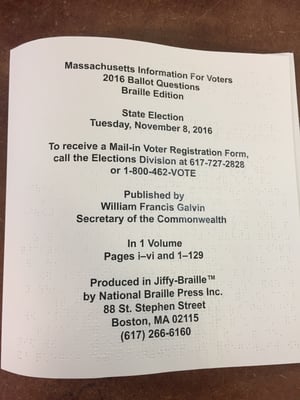For my last birthday, my two daughters presented me with a truly awesome and thoughtful gift: a contribution to National Braille Press. In their note, they recalled the wonderful bedtime reading rituals with their dad. We all loved NBP’s children’s braille books, and as they’ve grown up, they’ve hung onto those books. Perhaps someday I’ll get to read those (and new NBP books) to grandchildren, but that seems a good way off yet.
Now, what does this have to do with voting? Like reading, our participation in this most wonderful civic activity, voting, is a family affair. I remember the four of us walking into our local polling place a few years back when our youngest daughter came of voting age. By the way, it was a primary election in a non-presidential year. As you likely know, mid-term primary elections have woefully low turnout, but there we were, showing up to welcome our daughter as she joined the electorate for her first vote. Oh yes, her older sister is most assuredly a dedicated voter too, and she was lucky enough to be in school in Ohio when Bruce Springsteen was doing campus shows to energize young voters, and she taunts me to this day about getting to stand within 15 feet of him while he played acoustic guitar. Ugh!
I love voting, always have. For years, people with vision loss usually had to request some kind of assistance to cast their ballot. But, after widespread voting problems in 2000, advocates, including me, worked to get the Help America Vote Act (HAVA) passed. This law included accessibility requirements. As a result, I remember excitedly casting my first truly independent vote in the 2002 primary election in Maryland. I practically skipped out of the booth. The only thing that rivaled it was getting to mark a ballot to vote for my wife for school board back in Illinois.
OK, so, what does this have to do with braille? First, individuals who use braille as their reading medium should be provided an absentee ballot in braille, if requested. Braille ballots never really emerged as a practical access solution for voting at the local polling place, but braille is a critical tool for research and learning about voting and candidates. When independent access to newspapers and candidate information became possible for me with the emergence of online information in the 90s, I was thrilled to be able to prepare my own braille guide listing candidates and a bit of background. Thus armed, I knew I could vote independently, even spelling the names of my preferred candidates if for some reason that was necessary.

Just recently, I requested a braille sample ballot from my county Board of Elections. This is something I encourage everyone with a need for accessible media to do. The braille document is on its way, and just like my sighted family members who received a print sample ballot, I’ll have mine in my preferred accessible version. Then, I plan to show up at my polling place, and with an audio interface to the ballot, make my choices independently and privately.
Of course, the four of us Schroeders will all be voting in November, though alas, with the daughters away at school, we’ll not be able to go to the polling place together.
As I prepare to vote, and as another birthday comes around to remind me of my daughters’ gift to me and NBP last year, I’ll be using braille as one of my key tools for independence, and I’ll be thanking NBP for making braille widespread, commonplace, and yes, even, cool.
Our friends over at the American Foundation for the Blind (AFB) have assembled a very nice newsletter about voting at the following web link:
Sources:
By Paul Schroeder
